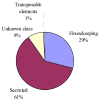An insight into the transcriptome and proteome of the salivary gland of the stable fly, Stomoxys calcitrans
- PMID: 19576987
- PMCID: PMC2737351
- DOI: 10.1016/j.ibmb.2009.06.004
An insight into the transcriptome and proteome of the salivary gland of the stable fly, Stomoxys calcitrans
Abstract
Adult stable flies are blood feeders, a nuisance, and mechanical vectors of veterinary diseases. To enable efficient feeding, blood sucking insects have evolved a sophisticated array of salivary compounds to disarm their host's hemostasis and inflammatory reaction. While the sialomes of several blood sucking Nematocera flies have been described, no thorough description has been made so far of any Brachycera, except for a detailed proteome analysis of a tabanid (Xu et al., 2008). In this work we provide an insight into the sialome of the muscid Stomoxys calcitrans, revealing a complex mixture of serine proteases, endonucleases, Kazal-containing peptides, anti-thrombins, antigen 5 related proteins, antimicrobial peptides, and the usual finding of mysterious secreted peptides that have no known partners, and may reflect the very fast evolution of salivary proteins due to the vertebrate host immune pressure. Supplemental Tables S1 and S2 can be downloaded from http://exon.niaid.nih.gov/transcriptome/S_calcitrans/T1/Sc-tb1-web.xls and http://exon.niaid.nih.gov/transcriptome/S_calcitrans/T2/Sc-tb2-web.xls.
Figures



Similar articles
-
Insight into the sialome of the Black Fly, Simulium vittatum.J Proteome Res. 2009 Mar;8(3):1474-88. doi: 10.1021/pr8008429. J Proteome Res. 2009. PMID: 19166301 Free PMC article.
-
An insight into the salivary transcriptome and proteome of the adult female mosquito Culex pipiens quinquefasciatus.Insect Biochem Mol Biol. 2004 Jun;34(6):543-63. doi: 10.1016/j.ibmb.2004.02.008. Insect Biochem Mol Biol. 2004. PMID: 15147756
-
An insight into the sialome of Glossina morsitans morsitans.BMC Genomics. 2010 Mar 30;11:213. doi: 10.1186/1471-2164-11-213. BMC Genomics. 2010. PMID: 20353571 Free PMC article.
-
An insight into the sialome of blood-feeding Nematocera.Insect Biochem Mol Biol. 2010 Nov;40(11):767-84. doi: 10.1016/j.ibmb.2010.08.002. Epub 2010 Aug 20. Insect Biochem Mol Biol. 2010. PMID: 20728537 Free PMC article. Review.
-
Disintegrins from hematophagous sources.Toxins (Basel). 2012 May;4(5):296-322. doi: 10.3390/toxins4050296. Epub 2012 Apr 26. Toxins (Basel). 2012. PMID: 22778902 Free PMC article. Review.
Cited by
-
Temporospatial fate of bacteria and immune effector expression in house flies fed GFP-Escherichia coli O157:H7.Med Vet Entomol. 2014 Dec;28(4):364-71. doi: 10.1111/mve.12056. Epub 2014 Apr 9. Med Vet Entomol. 2014. PMID: 24712451 Free PMC article.
-
An insight into the female and male Sabethes cyaneus mosquito salivary glands transcriptome.Insect Biochem Mol Biol. 2023 Feb;153:103898. doi: 10.1016/j.ibmb.2022.103898. Epub 2022 Dec 30. Insect Biochem Mol Biol. 2023. PMID: 36587808 Free PMC article.
-
An insight into the sialotranscriptome of Simulium nigrimanum, a black fly associated with fogo selvagem in South America.Am J Trop Med Hyg. 2010 Jun;82(6):1060-75. doi: 10.4269/ajtmh.2010.09-0769. Am J Trop Med Hyg. 2010. PMID: 20519601 Free PMC article.
-
An insight into the sialome of Simulium guianense (DIPTERA:SIMulIIDAE), the main vector of River Blindness Disease in Brazil.BMC Genomics. 2011 Dec 19;12:612. doi: 10.1186/1471-2164-12-612. BMC Genomics. 2011. PMID: 22182526 Free PMC article.
-
An insight into the sialome of the horse fly, Tabanus bromius.Insect Biochem Mol Biol. 2015 Oct;65:83-90. doi: 10.1016/j.ibmb.2015.09.002. Epub 2015 Sep 11. Insect Biochem Mol Biol. 2015. PMID: 26369729 Free PMC article.
References
-
- Arca B, Lombardo F, Francischetti IM, Pham VM, Mestres-Simon M, Andersen JF, Ribeiro JM. An insight into the sialome of the adult female mosquito Aedes albopictus. Insect Biochem Mol Biol. 2007;37:107–27. - PubMed
Publication types
MeSH terms
Substances
Grants and funding
LinkOut - more resources
Full Text Sources

